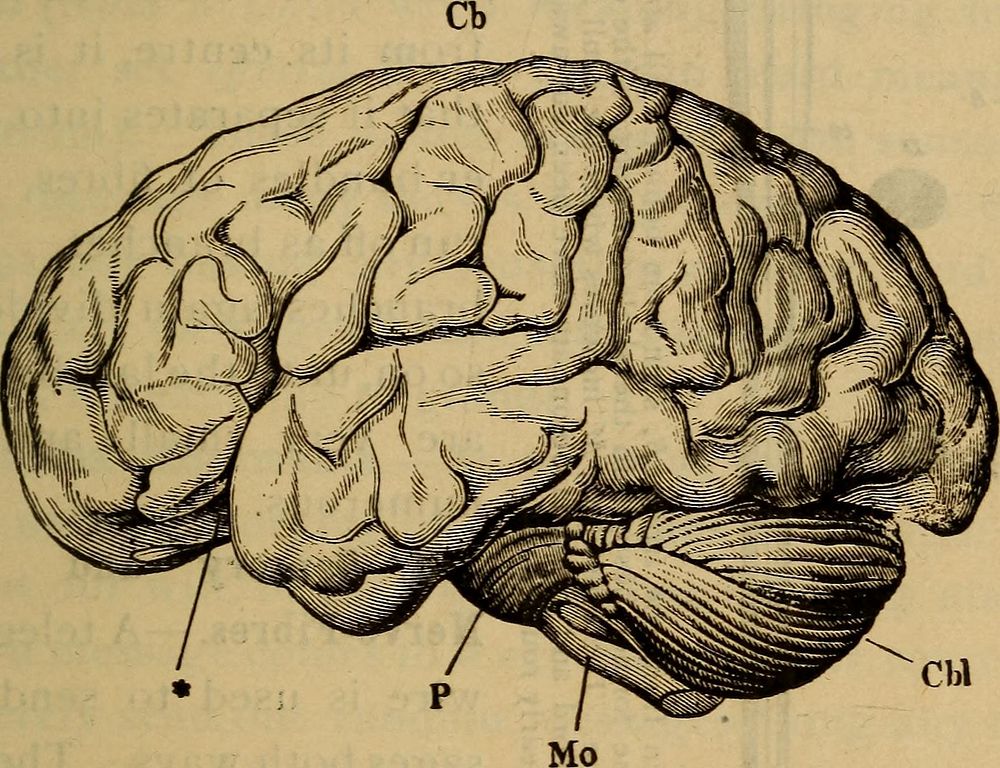https://creativecommons.org/publicdomain/zero/1.0/https://www.rawpixel.com/image/9975438

Identifier: humanbodybeginne00mart (find matches)Title: The human body. A beginner's text-book of anatomy, physiology and hygiene ..Year: 1884 (1880s)Authors: Martin, H. Newell (Henry Newell), 1848-1896 Martin, Hetty Cary, (from old catalog) joint authorSubjects: PhysiologyPublisher: New York, H. Holt and companyContributing Library: The Library of CongressDigitizing Sponsor: The Library of CongressView Book Page: Book ViewerAbout This Book: Catalog EntryView All Images: All Images From BookClick here to view book online to see this illustration in context in a browseable online version of this book.Text Appearing Before Image:general relationships of the parts of the brainas seen from the side. A^ cerebrum ; B, cerebellum ; Z>, medulla oblongata. of the brain are not really so widely separated as is rep-resented, for the sake of clearness, in Fig. 52. They lieclosely packed together, as shown in Fig. 53. The cerebrum fills all the front and upper part of theskull-cavity. It is much larger than the cerebellum, and 5. What does the brain of a grown person usually weigh? Whatare its chief parts ? How joined to the spinal cord? How do theylie in the skull ? Relative size? What are the cerebral hemispheres?How are their surfaces marked ? Name of the ridges? THE SPINAL CORD—THE NERVES. 195 its hinder end laps over it. A deep groove runs along thecerebrum from front to back and nearly cuts it in two.Its halves are named the right and left cerebral hemi-spheres^ and their surfaces are not smooth but are markedby numerous crooked furrows, with ridges between (Fig.53). The ridges are known as the convolutions.Text Appearing After Image:Fig. 53.—The brain from the left side. Cb, the cerebrum, or, rather, the leftcerebral hemisphere; Cbl^ the cerebellum; Mo^ the medulla oblongata. 6. The Spinal Cord is nearly round, and is about threequarters of an inch across and seventeen inches long.It does not reach as far as the lower end of the back-bone. 7. The Nerves start from the brain and spinal cord.Twelve pairs (crcmial nerves) are attached to the brain andgo out through holes in the skull; thirty-one pairs (spinalnerves) spring fi:om the sides of the spinal cord, and passout between the vertebrae. 6. Describe the spinal cord. How far does it reach? 7. Whence do the nerves start ? What is said of the cranial nerves ?Of the spinal? Of the nerve fibres? Describe the branching ofnerves. tgO SENSOl^y AND MOTOR NERVES.Note About ImagesPlease note that these images are extracted from scanned page images that may have been digitally enhanced for readability - coloration and appearance of these illustrations may not perfectly resemble the original work.
Original public domain image from Wikimedia Commons
Public DomainFree CC0 image for Personal and Business use